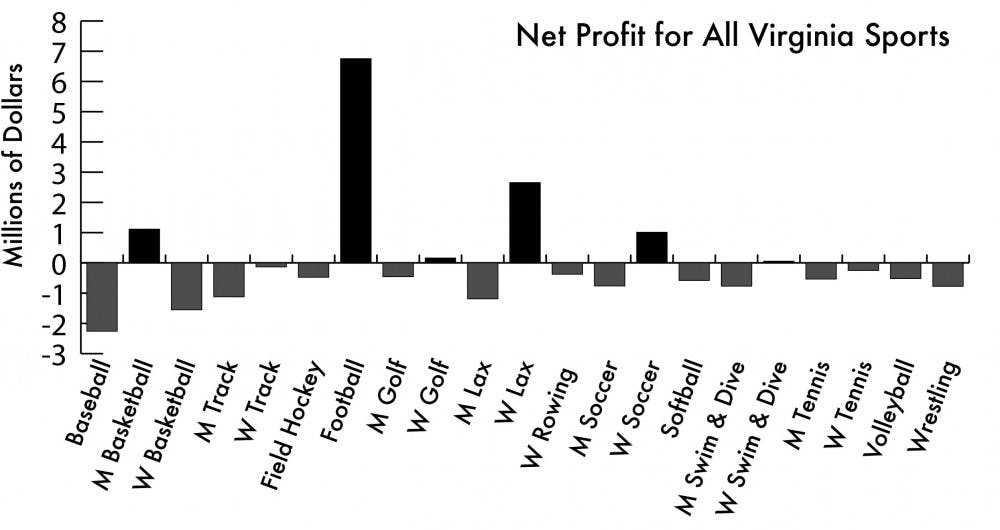Virginia’s most prominent sports team may be mired in a seven-game football losing streak. But for the teams operating outside of Scott Stadium, the fall has been highly successful. The women’s soccer and field hockey teams this week received bids to their respective NCAA tournaments, and the ranked men’s basketball team played one of its most anticipated games in years Tuesday night against Virginia Commonwealth University.
Athletic success does not come out of thin air; schools have to carefully balance the costs of additional teams, facilities and coaches with their on-field performances. Funding is always at a premium, and no school’s decisions are the same.
The Department of Education requires all schools that receive Title IX funding to release yearly reports on the revenue and expenses of their athletic departments under the Equity in Athletics Disclosure Act. Schools are not, however, held to particularly strict guidelines regarding how they must report their finances. This leaves openings for variation from school to school, but the EADA report comes closest to providing an overall comparison of NCAA schools.
“These reports are a little bit interesting, because it is a little bit about how you allocate things,” said Steve Pritzker, associate athletics director for business operations and chief financial officer of the athletic department. “Everyone looks at that differently. It’s a good first stab from the NCAA to try to get metrics that are across the board, but its still a stab.”
In the EADA numbers, Virginia comes out remarkably well, reporting the second highest total athletics revenue in the ACC behind Florida State, and the highest profit in the conference at almost $7 million for the 2010-11 school year, the most recent available data.
The school performed so impressively overall despite football pulling in the fourth lowest total in the conference and providing just 29.6 percent of the athletic department’s total revenue, the conference’s lowest proportion. The school has instead succeeded by finding revenue in other sports.
“I think the athletic department has done a strong job of saying, ‘Where can we spend? What is the right place to do it? How does it impact us in a positive way?’” Pritzker said. “I don’t know if anyone sat down and said, ‘The return on women’s golf will be X.’ I think it’s, ‘Is this where we can succeed and does it fit the profile of what we want to do?’”
Virginia is one of two schools in the ACC, along with North Carolina, that fields a team in each of the conference’s 25 varsity sports. The school even funded some sports, including women’s rowing, before the conference even sanctioned them.
“Some people argue that universities field too many teams, and some people argue that universities devote too much money to the teams they do have,” Assoc. Education Prof. Brian Pusser said in an email. “At the same time, there are universities and donors that would like to add teams and spend more money on athletics. Budgets vary dramatically within and across the divisions of the NCAA. Universities that compete at the highest level spend a great deal to achieve competitive excellence in all sports, and they hope that excellence generates additional revenue.”
For Virginia, the decision to build a large athletic program targeted not only athletic competitiveness but also financial efficiency.
“This is before my time, but my understanding was that in about 2000, 2001, there were some financial challenges, and the Board of Visitors came back and said ‘We want to fully fund everything that we do. If we’re going to do it, we’re going to do it right.’” Pritzker said. “That was a decision made a decade ago, if not more now, so the athletic department and the University to that effect has said that that’s a decision we want to go forth with, and that’s really parlayed into success across the board.”
The investment certainly seems to have paid off. Between 2002 and 2012, Virginia teams picked up 52 ACC championships and 7 NCAA championships, including at least one national title in each of the last four years.
An interesting facet of the EADA report comes from revenue and expenses that are listed as “not allocated by gender/sport.” Schools have various ways of reporting what goes into that category on both sides of the balance sheet, with room for wide variation between schools. Duke, for example, listed less than $4 million in “non-allocated” revenue in the 2011 report, while Virginia had more than $32 million listed. The schools nearly matched each other in total revenue, with Duke reporting $78.6 million and Virginia $81.3 million.
For Virginia, Pritzker broke down the “non-allocated” revenue into five categories: fundraising; money from the ACC; ticket revenue; assorted revenue from sources such as marketing and concessions; and student fees. The student fees are perhaps the most controversial — a 2011 USA Today report on athletic financing for public universities showed Virginia taking in close to $13 million in student fees — but Pritzker pointed out that schools use various means to stay competitive.
“At whatever time, the University Board of Visitors made the decision to go that route,” Pritzker said. “Some schools do tuition waivers for example or discounts, some will do payments from the university to the athletic department. … Student fees stick out, because it is a category, but certainly there are some of our peers that are being subsidized heavily in different ways. It’s a decision that the Board of Visitors made to make sure that across the board we are competitive in that way.”







